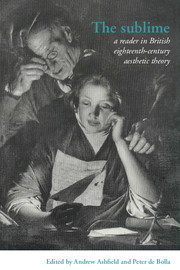Book contents
- Frontmatter
- Contents
- List of Abbreviations
- Introduction
- Part I The Longinian tradition
- Part II Rhapsody to rhetoric
- Part III Irish Perspectives
- Part IV The Aberdonian Enlightenment
- Part V Edinburgh and Glasgow
- Part VI From the Picturesque to the Political
- 41 A dissertation on oriental gardening (1772)
- 42 An essay on the picturesque (1794)
- 43 A review of The landscape (1795)
- 44 The history of the life of William Pitt, Earl of Chatham (1783)
- 45 Enquiry concerning political justice (1798)
- 46 Reflections on the revolution in France (1790)
- 47 A letter from the right honourable Edmund Burke to a noble lord (1796)
- 48 A vindication of the rights of man (1790)
- 49 Letters written in France (1790)
- 50 A tour in Switzerland (1798)
- Sources and further reading
43 - A review of The landscape (1795)
Published online by Cambridge University Press: 05 June 2012
- Frontmatter
- Contents
- List of Abbreviations
- Introduction
- Part I The Longinian tradition
- Part II Rhapsody to rhetoric
- Part III Irish Perspectives
- Part IV The Aberdonian Enlightenment
- Part V Edinburgh and Glasgow
- Part VI From the Picturesque to the Political
- 41 A dissertation on oriental gardening (1772)
- 42 An essay on the picturesque (1794)
- 43 A review of The landscape (1795)
- 44 The history of the life of William Pitt, Earl of Chatham (1783)
- 45 Enquiry concerning political justice (1798)
- 46 Reflections on the revolution in France (1790)
- 47 A letter from the right honourable Edmund Burke to a noble lord (1796)
- 48 A vindication of the rights of man (1790)
- 49 Letters written in France (1790)
- 50 A tour in Switzerland (1798)
- Sources and further reading
Summary
Sublimity. This attribute of objects of sight seldom occurs on the face of nature, in its natural state, comparatively with most of those which have been enumerated. Mountain scenery, how grand or magnificent it may be, is not, on that account, the more sublime; an extent of water, though wide as the sea itself, will not admit of the epithet, while it remains in a calm, unagitated state; any more than will an extent of country covered with snow; unless the idea of unbounded space raise it in some degree: but how infinitely more is this idea capable of exciting it, in viewing space itself, – in beholding the universe, – in looking towards infinity!
The sublime seems to require that the higher degrees of astonishment should be roused, to demonstrate its presence: a degree of terror, if not of horror, is required to produce the more forcible emotions of the mind, which sublimity is capable of exciting.
A giant precipice, frowning over its base, whether we view it from beneath, or look downward from its brink, is capable of producing sublime emotions. A river tumbling headlong over such a precipice, especially if it be viewed with difficulty and a degree of danger, real or imaginary, still heightens those emotions. Lightning, thunder, and hurricanes may produce them.
- Type
- Chapter
- Information
- The SublimeA Reader in British Eighteenth-Century Aesthetic Theory, pp. 276 - 277Publisher: Cambridge University PressPrint publication year: 1996



